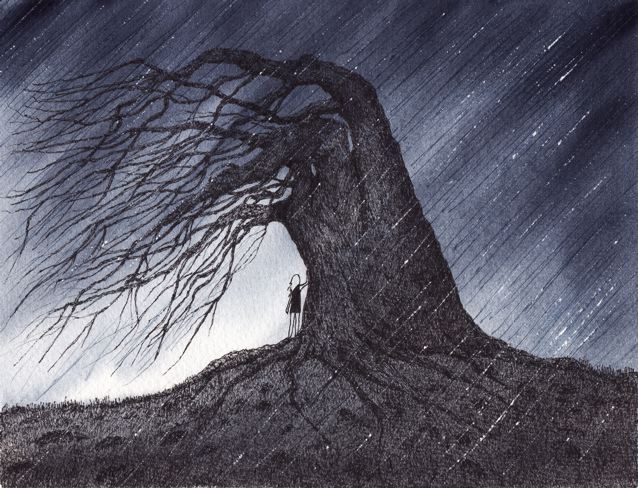 Clear and chilly this early Tuesday on California’s north coast — we’re set for clear skies the rest of this week with a ‘chance of rain’ on Sunday, which means maybe a ‘drizzle’ if anything.
Clear and chilly this early Tuesday on California’s north coast — we’re set for clear skies the rest of this week with a ‘chance of rain’ on Sunday, which means maybe a ‘drizzle’ if anything.
Although our weather can be ho-hum at times — a day in January can be mistaken for one in July — other parts of the US are not in such a boring place. Tornadoes, for an example, grow out of thunderstorms, which are rare up here, but do occur. Last month, at least four were reported in northern California during some bad weather, including a fairly-large one near Sacramento.
(Illustration found here).
But nothing like the US Midwest.
According to Harold Brooks, a senior researcher at the National Oceanic and Atmospheric Administration’s National Severe Storms Laboratory in Norman, Okla., the flat middle of America is prime land for twisters — via yesterday’s Christian Science Monitor:
Tornadoes develop from thunderstorms.
There are certain ingredients needed for a thunderstorm, says Dr. Brooks.
First, there needs to be warm, moist air near the ground.
Then there has to be cold and relatively dry air between 3 and 7 kilometers above the ground.
Under the right conditions, the warmer air near the surface will rise up like a balloon into the colder air prompting the formation of a thunderstorm.
If these updrafts occur in a spot where winds are changing speed and direction, it can create a horizontal rotation in the air.
Rising air causes the spinning air to tilt, creating the tornado’s characteristic funnel cloud.
In the US, warm, moist winds blowing from the Gulf of Mexico meet the cold, dry winds from the Rocky Mountains, creating ideal conditions for tornadoes to form.
During spring, this tends to happen most often in Texas, Oklahoma, Nebraska and Kansas, the states that comprise the core of “Tornado Alley.”
Arkansas lies outside of this core, but it still gets its fair share.
Like its neighbor Oklahoma, it lies at the intersection of winds from the Gulf and the Rockies.
Tornado activity in Oklahoma is only slightly greater than Arkansas, and more confined to the spring season, Brooks says.
And growing up in Alabama so many years ago, we also experienced ‘its fair share’ of twisters — they were the scourge of the spring and early-summer months. My grandparents — like many, many others — had a tornado shelter as part of their farm operation. I never used it, and during my youth never heard of anyone else using them. Maybe not enough time, or something. But the shelters were there.
In the last couple of days, a shitload of people in the Midwest really, really used them.
After blasting through Kansas/Oklahoma/Iowa, the storm system powered into the deep south yesterday, killing at least 11, bringing the nasty death total over the last couple of days to 30.
Some of the stories are frightful and dramatic — this of James Purvis, 84, and his son, Jim, 55, who rode out a biggie — via Yahoo News this morning:
The father and son were watching television shortly before 8 p.m. Sunday when weather conditions began to worsen.
After the TV signal went out, the men began watching the skies like they had done so many times before here in tornado-prone central Arkansas.
Outside of their three-bedroom, two-bath brick house, nightfall was setting in.
But looking southwest, they could see dark clouds swirling angrily.
“You could hear the roar,” the elder Purvis said.
The Purvis family has seen its share of tornadoes through the years and barely escaped calamity when another deadly twister struck Vilonia three years ago.
Sunday night, Jim Purvis said, was very different.
“It didn’t look like the stereotypical tornadoes you see on TV,” he said.
“It was just a wall of crap coming at you.”
Some have estimated that Sunday’s tornado was at least a half-mile wide.
It devastated Vilonia, a bedroom community of 4,100 about 35 miles north of Little Rock.
In a matter of minutes, the twister crushed shopping centers, flipped cars like toys, ripped mature trees from their roots, and leveled block after block of homes.
Nine people were reportedly killed on the same street, just a few blocks from where the Purvises lived.
Seeing the Purvises’ home in shambles makes you wonder how they survived.
After realizing they needed to take cover, father and son headed to a hallway bathroom, but the elder Purvis almost didn’t make it.
“He stopped because he heard our greenhouse being blown away,” said Jim, shaking his head.
“He missed getting smashed by the brick chimney falling by a foot and half.”
His dad, the kind of guy who sees life as the glass being half-full, acknowledged his misstep on Monday.
“Curiosity got the best of me,” said the elder Purvis, who suffered lacerations to his left arm, head, and right hand.
“But I’m a hell of a lot smarter today than I was yesterday.”
…
In his 84 years James Purvis, a retired biology teacher and railroad worker, made it home from the Korean War, survived a head-on car crash, and underwent triple-bypass surgery.
“There are two things we don’t have control over: life and death,” said James Purvis, a widower.
“Everything in between is our responsibility.”
Twisting life amidst chaos.